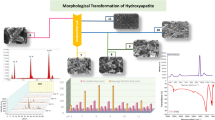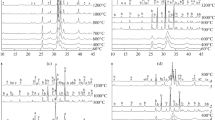Abstract
In the last decade synthetic apatites mimicking the human natural one have been widely prepared and characterized from the physico-chemical point of view; however a shading zone is still remaining related to the evaluation and distinction of the less crystalline part, almost amorphous, and the crystallographically well ordered, nano-sized part, inside the apatite itself. Actually natural apatite forming bone tissue can include both types of crystals whose prevalence is dependent from the specific bone evolution stage and the specialized tissue performance. The quantitative description of such a combination usually represents a puzzling problem, but the result can also clarify the definition of “crystallinity in apatite” that appears still controversial. Many different synthetic apatites, including those nucleated on organic templates, were analyzed with different techniques (X-ray diffraction, transmission electron microscopy, and so on) to clarify the true nature of the disordered part. The results, manipulated by the classical methodologies devised for substances with highly perturbed structural order, led to establish that only specifically prepared amorphous calcium phosphate is really a glass, while the distorted portion coexisting with more or less crystalline regions is simply nanocrystalline. Moreover, at the conceptual limit of crystallinity tending to zero, the two models surprisingly cease to be conflicting.
Similar content being viewed by others
References
R. Z. LEGEROS, in “Calcium phosphates in oral biology and medicine,” Monographs in oral science, vol. 15, edited by K. H. Myers (AG Publishers, Basel, 1991).
C. REY, in “Calcium phosphates for medical applications,” Calcium phosphates in biological and industrial systems, edited by Z. Amjad (Kluwer Acad. Publishers, Boston, 1998).
W. SUCHANEK and M. YOSHIMURA, J. Mater. Res. 13 (1998) 94.
H. M. KIM, J. Ceram. Soc. Japan 109 (2001) S49.
T. S. B. NARASARAJU and D. E. PHEBE, J. Mater. Sci. 31 (1996) 1.
S. RINNERTHALER, P. ROSCHGER, H. F. JAKOB, A. NADER, K. KLAUSHOFER and P. FRATZL, Calcif. Tissue Int. 64 (1999) 422.
I. ŽIŽAK, O. PARIS, P. ROSCHGER, S. BERNSTORFF, H. AMENITSCH, K. KLAUSHOFER and P. FRATZL, J. Appl. Cryst. 33 (2000) 820.
A. TAMPIERI, G. CELOTTI and E. LANDI, Anal. and Bioanal. Chem. 381 (2005) 568.
E. LANDI, A. TAMPIERI, G. CELOTTI and S. SPRIO, J. Eur. Ceram. Soc. 20 (2000) 2377.
A. TAMPIERI, G. CELOTTI, S. SPRIO, A. DELCOGLIANO and S. FRANZESE, Biomaterials 22 (2001) 1365.
A. TAMPIERI, G. CELOTTI, E. LANDI, M. SANDRI, N. ROVERI and G. FALINI, J. Biomed. Mater. Res. 67A (2003) 618.
E. LANDI, A. TAMPIERI, G. CELOTTI, L. VICHI and M. SANDRI, Biomaterials 25 (2004) 1763.
A. TAMPIERI, G. CELOTTI, E. LANDI and M. SANDRI, Key Eng. Mater. 2051 (2004) 264–268
R. Z. LEGEROS, D. MIJARES, J. PARK, X. F. CHANG, I. KHAIROUN, R. KIJKOWSKA, R. DIAS and J. P. LEGEROS, Key Eng. Mater. 7 (2005) 284–286.
R. Z. LEGEROS, W. P. SHIRRA, M. A. MIRAVITE and J. P. LEGEROS, in CNRS n. 230 (Paris, 1973) 105.
B. E. WARREN, in “X-ray diffraction” (Addison-Wesley, Reading, 1969).
T. EGAMI and S. J. L. BILLINGE, in “Underneath the Bragg peaks: structural analysis of complex materials” (Pergamon, Amsterdam, 2003).
J. W. RICHARDSON, JR., in “Background modelling in Rietveld analysis,” The Rietveld method, edited by R. A. Young (I. U. Cr.-Oxford University Press, Oxford, 1996) p. 102.
L. KELLER and W. A. DOLLASE, J. Biomed. Mater. Res. 49 (2000) 244.
A. S. POSNER and F. BETTS, Acc Chem Res. 8 (1975) 273.
A. TAMPIERI, G. CELOTTI, F. SZONTAGH and E. LANDI, J. Mater. Sci.: Mater. Med 8 (1997) 29.
M. TAMAI, M. NAKAMURA, T. ISSHIKI, K. NISHIO, H. ENDOH and A. NAKAHIRA, J. Mater. Sci.: Mater. Med. 14 (2003) 617.
G. MOUNTJOY, J. Phys. Condens. Matter. 11 (1999) 2319 and references therein.
A. FONTCUBERTA I MORRAL, H. HOFMEISTER and P. ROCA I CABARROCAS, J. Non-cryst. Solids 284 (2002) 299–302.
Author information
Authors and Affiliations
Rights and permissions
About this article
Cite this article
Celotti, G., Tampieri, A., Sprio, S. et al. Crystallinity in apatites: how can a truly disordered fraction be distinguished from nanosize crystalline domains?. J Mater Sci: Mater Med 17, 1079–1087 (2006). https://doi.org/10.1007/s10856-006-0534-7
Received:
Accepted:
Published:
Issue Date:
DOI: https://doi.org/10.1007/s10856-006-0534-7




